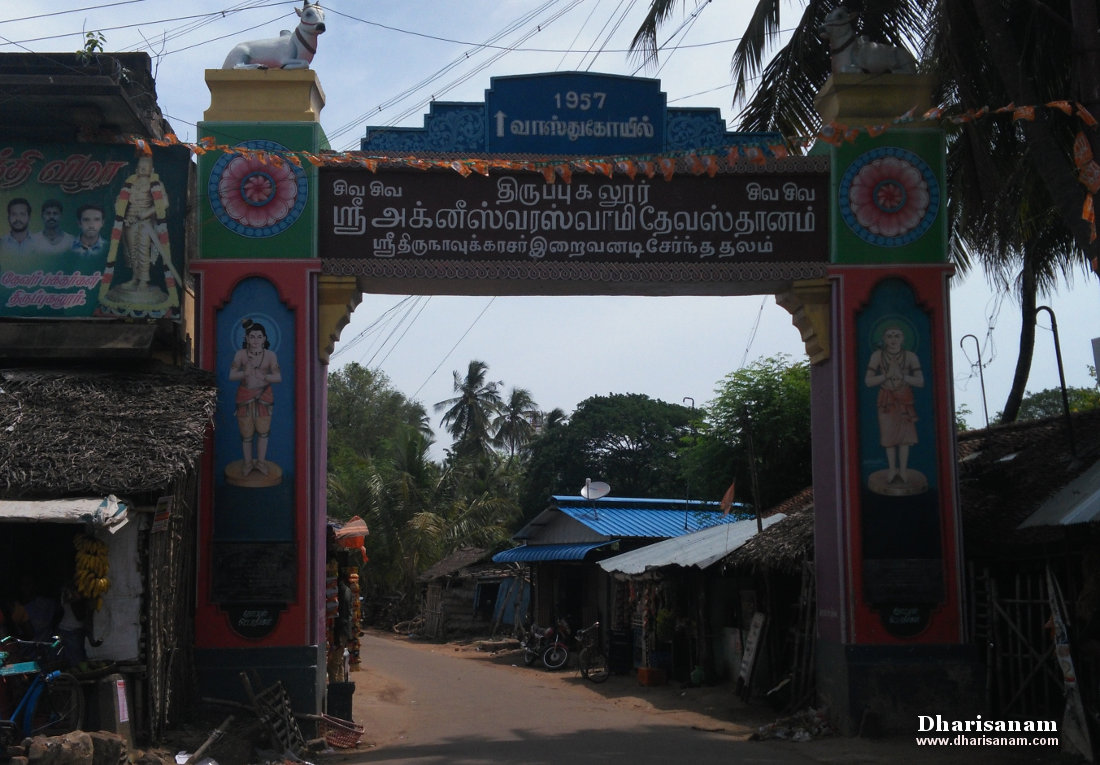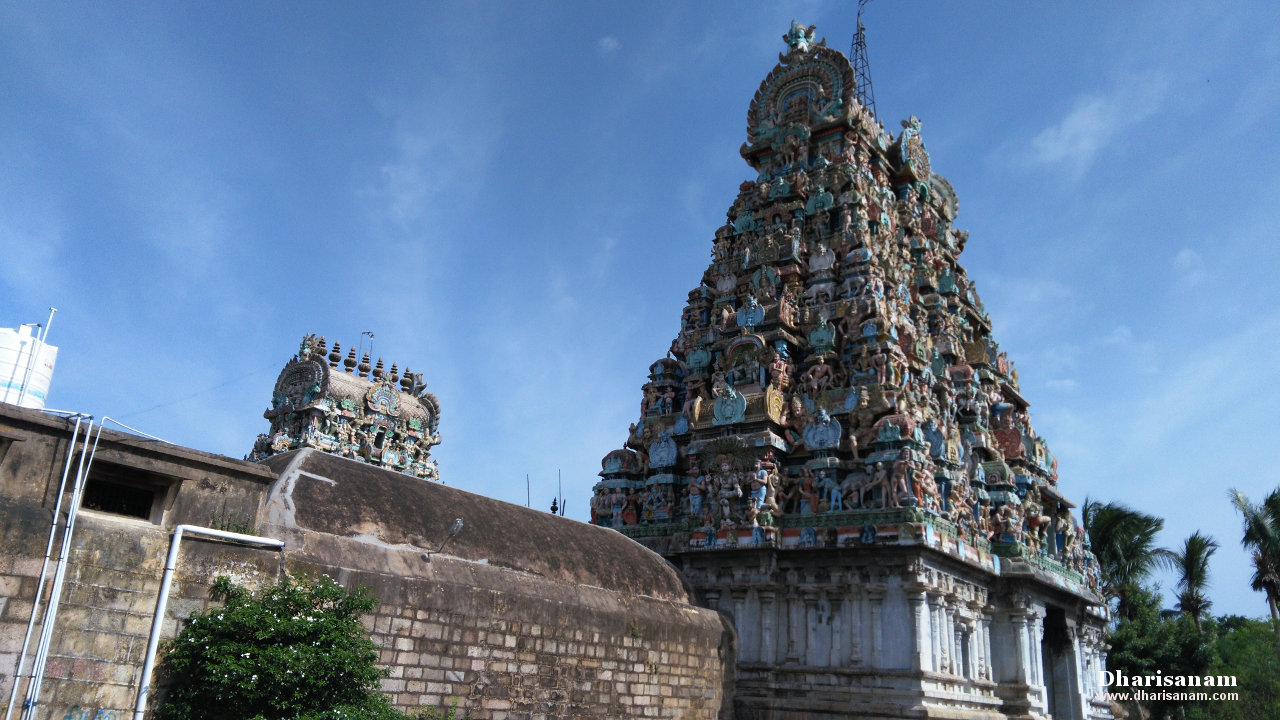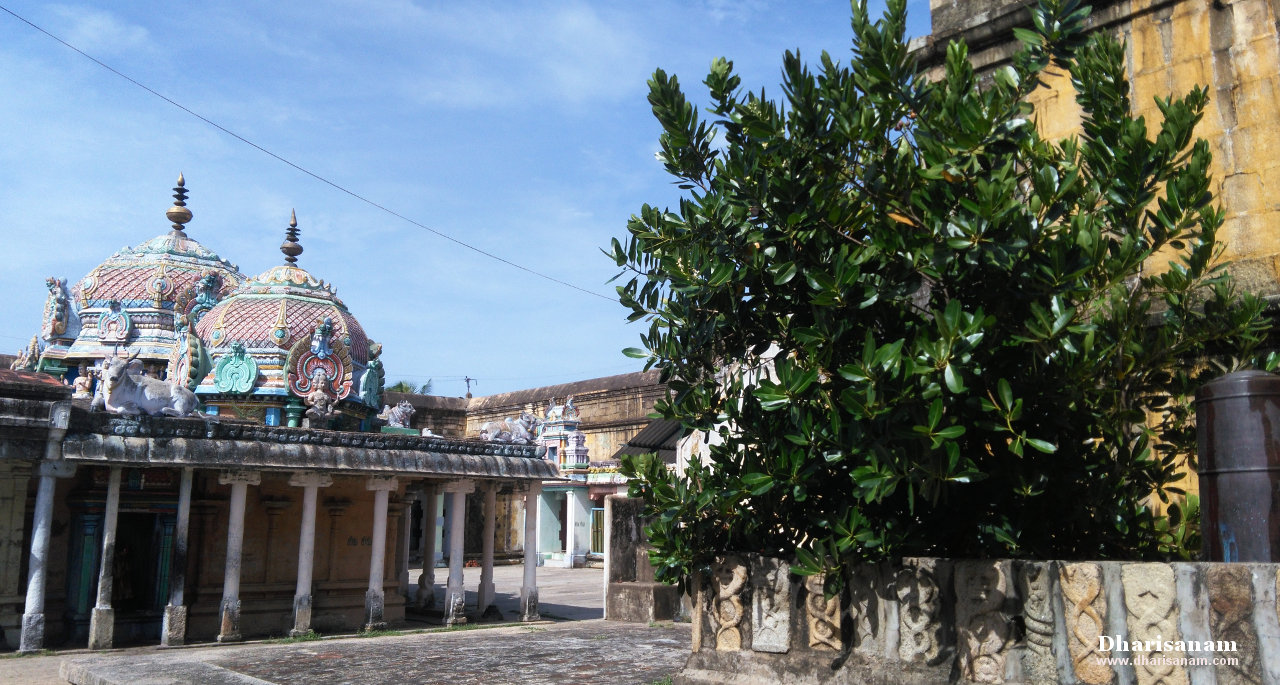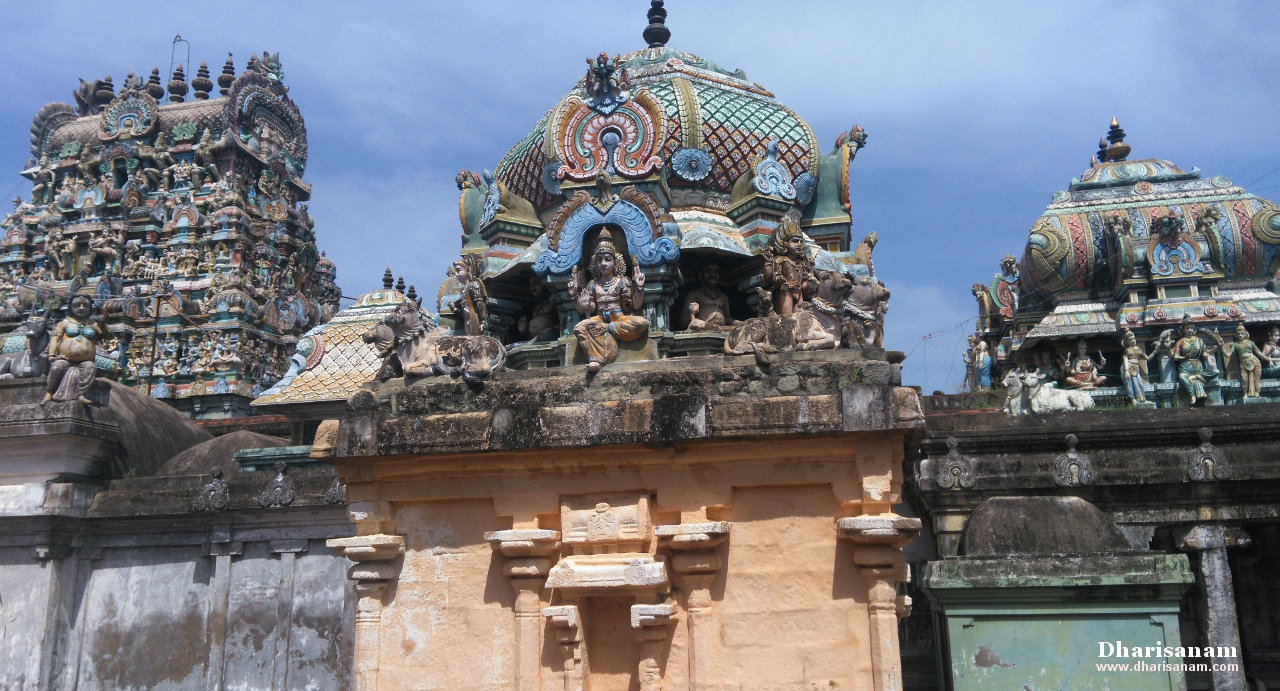Visited on: 12th June, 2018.
Location
Thiru Pugalur is situated at a distance of about 7 kms to the west of Sannanallur. Sannanallur is on the Thiruvarur to Peralm route.
It is about 33 kms away from Mayiladuthurai, 20 kms away from Karaikkal, 20 kms away from Thiruvarur and 10 kms away from Nannilam.
Other Devara Paadal Petra Shiva Sthalams near this place are –
Thiru Pukalur Vardhamaneecharam, Ramanadeecharam, Thirumarugal, Thiru Sathamangai, Nannilam, Thiru Kondeecharam, Thiru Panaiyur, Thiru Payatrur and Thiru Chenkattangudi.
General Information
| Moolavar | Sri Agneeswarar, Sri Konappiraan, Sri Saranyapureeswarar, Sri Punnagavana Nathar |
| Ambal | Sri Karuntharkuzhali, Sri Choolikambal |
| Theertham (Holy water) | Agni Theertham, Bana Theertham |
| Sthala Vriksham (Sacred Tree) | Punnai tree |
| Pathigam (Hymn) rendered by | Saint Thirugnanasambanthar-2, Saint Thirunavukarasar (Appar)-5, Saint Sundaramurthy (Sundarar)-1 |
- This is one of the 276 Devara Paadal Petra Shiva Sthalams and 75th Shiva Sthalam on the Southern bank of the river Cauveri in Chozha Nadu (Thenkarai).
- Lord Shiva in this temple is a Swayambumurthi (self-manifested).
- Saint Thirunavukkarasar attained salvation (“Mukthi”) and sang his last pathigam here.
- This is one of the 44 Paadal petra sthalams where the “Moovar” (the three saints - Saint Thirugnanasambanthar, Saint Thirunavukarasar (Appar) and Saint Sundaramurthy (Sundarar) had rendered their Pathigams.
- This is the birthplace of Saint Muruga Nayanar, one of the 63 Nayanmars.
- This east facing temple has 2 corridors and its main tower (Rajagopuram) has 5-tiers.
- Visiting this temple is considered auspicious for those born under the influence of “Sadhayam” nakshatram (star).
- This temple is famous for performing “Vastu” pooja.
- The last consecration ceremony (Maha Kumbabishekam) took place on 27.03.2003.
History of the Temple
There are two Devara Paadal Petra Shiva Sthalams in the same complex - Thirupukalur and Thiru Pukalur Vardhamaneecharam.
The historical names of this place are Punnagavanam, Saranyapuram and Rakthaaranyam.
There are 67 stone inscriptions in this temple which date back to the periods of various Chola kings like Raja Rajan, Rajendran, Kulothungan-I and Kulothungan-III. It is believed that this temple was originally built by Raja Raja Cholan-1.
This temple is under the administrative control of (Thiruppugalur) Velakurichi Adheenam and HR&CE.



Legend
It is believed that Lord Agni, the fire god, worshiped Lord Shiva here. Lord Shiva blessed Agni by giving him a darshan in the form of Chandrasekarar. Agni was relieved of his sins. Hence the lord is praised as Sri Agneeswarar.
It is believed that when the demons were terrorising the devas and the sages, they sought asylum in this place. Hence, this place gets the name “Pukalur” (“pukal” means asylum and “oor” means village in Tamil).
As per legend, demon Banasuran, a great Shiva devotee, dug a huge tank (“Akazhi”) around this temple. He tried to carry away the main Shivalingam from here to his mother Mathiniyar’s place for her worship, but he failed in his efforts to do so. During this process, the lord’s lingam got slightly tilted to one side. Hence, this lord is also called “Sri Kona Piraan” (“Konal” means tilted in Tamil).
Another legend associated with this temple is that of king Nalan. King Nalan was under the clutches of Lord Saneeswarar. But after worshiping Lord Shiva here, he heard a divine voice that told him that he would be relieved from the clutches of Lord Saneeswarar soon. Hence Lord Saneeswarar here is considered as “Anugraha Moorthy”.
As per legend, Saint Thirunavukkarasar (Appar) spent a considerable time of his life here and served (“Uzhavaarappani”) the lord of this temple. He used to serve the lord in various Shiva temples by cleaning the grounds and paths to enable devotees to walk comfortably. He did so using a tool called “Uzhavaram”. The lord wanted to test Appar’s devotion. The lord put some gems at the place where Appar was cleaning. But Appar did not show any regard for these gems and threw them out along with the other wastes. The lord then sent some dancers (“Arambayar”) from the celestial world in order to entice him. However, Appar promptly sent them away. This proved to the lord that Appar was completely devoted to him and had no regard for any of the “three wishes” – land, woman and gold.
Appar repeatedly prayed to the lord asking for salvation. He sang his last pathigam, “Ennuken, en solli ennukeno…..’ and by grace of the lord, he attained salvation (“Mukthi”) at the age of 81 on a “Chithirai Sadhayam” star day. He was assimilated into the lord’s idol. This place is praised as “salvation place”. To commemorate this event, a grand festival is celebrated every year on this day called Appar festival.
According to legend, Saint Sundaramurthy Nayanar visited this place to worship the lord and wanted to get some money from him. The Nayanar wanted this money for his wife, Paravai Nachiyar in Thiruvarur. At this time, this temple was undergoing some renovations. After worship, he wanted to take rest for some time. He kept few bricks to support his head and took a nap. On waking up, he found that the bricks were converted into golden blocks by Lord Agneeswara’s grace. The saint was overwhelmed with joy and rendered his “Padhigam”.
Another legend associated with this temple involves a nearby temple (and also a Devara Paadal Petra Sthalam) called Ramanadeecharam. The legend is that a local king prayed to Lord Shiva for child boon and performed a yagna. Through his divine voice, the lord informed the king that he would be blessed with a girl child soon and this child would be an incarnation of Goddess Parvathy herself. At a later date, when the king went to the forest for hunting, he found four young girls under a tree. He brought them to his palace and raised them as his own daughters. When they attained the marriageable age, the king prayed to Lord Shiva and requested the lord to marry them. It is believed that the lord married them. Hence, there are four temples nearby each housing one of the goddesses – Sri Karundhar Kuzhali (in this temple), Sri Vanduvaar Kuzhali in Thirumarugal, Sri Sarivar Kuzhali in Ramanadeecharam and Sri Vaaitha Thirukuzhal Nayaki in Thiruchengattangudi.
It is believed that these four Goddesses once helped a pregnant woman deliver her child. Hence, these goddesses are referred by the common name “Sri Choolikambal” (“Chool” or “Karu” means pregnancy in Tamil). It is believed that when the goddesses returned to the temple after this incident, they stayed at a little distance away from the lord’s shrine. This is symbolically represented in all the four temples as the goddess’s shrine is located separate from the lord’s shrine. In this temple, Goddess Parvathy is also praised as Sri Karu Katha Ambigai.
Lord Shiva is believed to have blessed Goddess Boomi Devi and Sage Satyashada with his Cosmic dance here.
It is believed that Agni, Sage Bharadwaj, all the 18 Siddhars, Saints Thirugnanasambanthar, Appar and Sundarar have worshiped Lord Shiva here.
Deities in the temple
Other than the shrines of Lord Shiva and Goddess Parvathy, shrines and idols of Narthana Vinayakar, Murugan with his consorts, Natarajar, Somaskandar, Lakshmi, Annapoorani, Saraswathi (Kalaimakal), Thirimukasooran (three faced asura), Kalasamharamurthy, Kasi Viavanathar, Vamadeva Lingam, Chandikeswarar, Somanayakar with Somanayagi, Bairavar, Chinthamaneecharar, Agni Bhagavan, 63 Nayanmars, Agora Lingam, Poothesvarar and Pavishyeswarar can be seem in the main hall and the corridors.
The idols of Navagraham are not placed in their regular form but are placed in an “L” shaped form.
Lord Saneeswarar’s shrine also houses an idol of King Nalan.
In the “koshtam” (place surrounding the sanctum sanctorum), idols of Vinayakar, Agasthiyar, Natarajar (in stone), Dakshinamurthy, Queen Chembian Maadevi (worshiping Lord Shiva), Annamalaiyar, Pitchadanar, Aalingana Kalyanasundarar and Durgai can be seen.
There are many Shiva lingams here and each of them in a separate shrine. These lingams were worshiped by Lord Murugan, Mahavishnu, Neelakanda Sivachariyar, Sages Jamadagni, Bharadwajar, Thatheesi, Vyasar, Birugu, Pulasthiyar, Jaabali, Lord Indra and Varadarayar.
There is a separate shrine for Saint Thirunavukkarasar in the hall.









Salient Features
In this temple, Lord Somaskandar is considered very auspicious.
This is the only place where Lord Agni has an idol made of stone and has a separate shrine. Lord Agni is seen with two heads, three legs, seven hands, four horns and seven sparks of fire on his head. The procession idol of Agni is also in the same form.
The procession idols of Agni, Chandrasekarar, Thiripuranthakar and Brahma are incredibly beautiful.
There are three Shivalingams in the names of Lord Bhoodeshwarar, Lord Vardamaneeswarar and Lord Bhavishyeswarar. These three lingams are believed to symbolise the past, present and the future.
This is the birthplace of Muruga Nayanar, one of the 63 Nayanmars. The Nayanar offered flowers to the lord every day with full devotion. He attained salvation at Nallur Perumanam (Aachalpuram) during Saint Thirugnanasambanthar’s wedding.
Behind the sanctum sanctorum, on either sides of Lord Annamalaiyar, there are idols of Lord Mahavishnu and Lord Brahma. Devotees can enjoy the darshan of all the three lords (Trimurthys) – Brahma, Vishnu and Shiva. This is considered to be very auspicious.



As per “Periya Puranam”, this is the place where five Nayanmars, (Thirugnanasambanthar, Thirunavukkarasar, Siruthondar, Thiruneelanakkar and Muruga Nayanar) sat together and discussed about Saivism. They spent some time here at Muruga Nayanar’s mutt.
There are certain paintings in the walls of the main hall which depicts various legends associated with this temple.
1. One painting shows that Appar threw away the gems (“Navamanikal”) along with the other wastes that he had collected while cleaning the temple.
2. Another painting depicts that some dancers from the celestial world tried to disturb Appar’s service. However, he sent them away.
3. Another painting shows that Sundarar was sleeping with a brick supporting his head and found that it had turned into a golden block the next morning by the grace of the lord.
4. Another panting shows that Banasuran was trying to remove the Shivalingam for his mother’s worship.
5. Another painting shows that Lord Agni was blessed with the lord’s darshan in the form of Chandrasekarar.
There are four beautiful reliefs on a wall in the corridor depicting Lord Agri worshiping Lord Shiva, Saint Appar’s last worship of the lord, Kamadenu worshiping the lord by pouring her milk, and some kings and queens worshiping the lord.
This temple’s tank, Agni Theertham is in the form of a semicircle (“Akazhi” in Tamil) around the temple.
Lord Saneeswarar here is praised as “Anugraha Sani” and worshiping him here is considered to be very auspicious.
Greatness of this temple
This is a “parihara sthalam” for those born under the influence of the “Sadhayam” nakshatram (star).
Devotees whose birth star is Sadhayam can visit this temple for special poojas.
Devotees believe that worshiping the lord here will lead to removal of the sins that they might have accrued in their previous births.
This temple is famous for performing “Vastu” pooja.
Important Festivals
The two most important festivals celebrated in this temple are –
10-day Vaikasi Poornima Brahmotsavam in the Tamil month of Vaikasi (May-June) commemorating the event of Lord Shiva granting darshan to Lord Agni.
10-day “Appar Baktha Utsav” in the Tamil month of Chithirai (Apr-May) beginning on Sadhaya Star day. This festival is held every year commemorating the event of Lord Shiva granting salvation to Appar.
Some of the other festivals celebrated here are -
Aani Thirumanjanam in the Tamil month of Aani (June-July),
Aadi Pooram in the Tamil month of Aadi (July-Aug),
Vinayakar Chaturthi in the Tamil month of Aavani (Aug-Sept),
Navarathri in the Tamil month of Purattasi (Sept-Oct),
Skanda Shashti and Annabishekam in the Tamil month of Aippasi (Oct–Nov),
Thiru Karthikai and Somavaram in the Tamil month of Karthikai (Nov-Dec),
Thiruvadhirai in the Tamil month of Markazhi (Dec-Jan),
Makara Sankranthi in the Tamil month of Thai (Jan-Feb),
Shivrathri in the Tamil month of Masi (Feb-Mar) and
Panguni Uthiram in the Tamil month of Panguni (Mar-Apr).
Pradosham, Pournami and Sankatahara Chaturthi are also observed regularly.
Temple Timings
From 06:30 AM to 12:30 PM and from 04:00 PM to 09:00 PM.
Temple Address
Sri Agneeswarar Temple,
Thirupugalur Post,
Thirukkanapuram Via,
Thirumarugal Taluk,
Nagapattinam District,
Tamil Nadu – 609 704.
Tele: +91 – 4366 - 237176, 94435 88339.
This temple’s priest Sri Ramanatha Gurukkal can be contacted at +91 - 94878 64858.







Pathigam (Hymn) with English transliteration and Tamil meaning.
Saint Thirunavukkarasar (Appar) visited this temple and sang this Pathigam.
Devotees visiting this temple should make it a practice to recite this Pathigam.
Pathigam No.6.099.
எண்ணுகேன் என்சொல்லி எண்ணு கேனோ
எம்பெருமான் திருவடியே எண்ணி னல்லாற்
கண்ணிலேன் மற்றோர் களைக ணில்லேன்
கழலடியே கைதொழுது காணி னல்லால்
ஒண்ணுளே ஒன்பது வாசல் வைத்தாய்
ஒக்க அடைக்கும்போ துணர மாட்டேன்
புண்ணியா உன்னடிக்கே போது கின்றேன்
பூம்புகலூர் மேவிய புண்ணி யனே.
“Eṇṇukēṉ eṉsolli eṇṇu kēṉō
emperumāṉ thiruvaṭiyē eṇṇi ṉallāṟ
kaṇṇilēṉ matṟōr kaḷaika ṇillēṉ
kazhalaṭiyē kaithozhuthu kāṇi ṉallāl
oṇṇuḷē oṉpathu vāsal vaiththāy
okka aṭaikkumpō thuṇara māṭṭēṉ
puṇṇiyā uṉṉaṭikkē pōthu kiṉtṟēṉ
pūmpukalūr mēviya puṇṇi yaṉē”.
புண்ணியா, அழகிய புகலூர் மேவிய புண்ணியனே, நினையுந்தன்மை உடையேனாகிய நான் எம்பெருமானாகிய நினது திருவடியை விரும்பி நினையின் அல்லது வேறு எதனை விரும்பி நினைவேன்? நினது கழலடியையே கைதொழுது காணின் அல்லது வேறு காட்சியில்லேன்; மற்றொரு பற்றுக்கோடும் இல்லேன். யான் வாழ்வதற்குப் பொருந்திய உறையுளாகிய இவ்வுடம்பிலே ஒன்பது வாசல் வைத்தாய். அவையாவும் ஒரு சேர அடைக்கப்படும் காலத்து மேற்குறித்தவாறு உன்னையே நினைதலையும் காணுதலையும் செய்யமாட்டேன். ஆதலின் அக்காலம் வாராதபடி இப்பொழுதே உன் திருவடிக்கே வருகின்றேன். என்னை ஏற்றுக் கொண்டருள்வாயாக.
அங்கமே பூண்டாய் அனலா டினாய்
ஆதிரையாய் ஆல்நிழலாய் ஆனே றூர்ந்தாய்
பங்கமொன் றில்லாத படர்ச டையினாய்
பாம்பொடு திங்கள் பகைதீர்த் தாண்டாய்
சங்கையொன் றின்றியே தேவர் வேண்டச்
சமுத்திரத்தின் நஞ்சுண்டு சாவா மூவாச்
சிங்கமே உன்னடிக்கே போது கின்றேன்
திருப்புகலூர் மேவிய தேவ தேவே.
“Aṅkamē pūṇṭāy aṉalā ṭiṉāy
āthiraiyāy ālnizhalāy āṉē ṟūrnthāy
paṅkamoṉ tṟillātha paṭarcha ṭaiyiṉāy
pāmpoṭu thiṅkaḷ pakaithīrth thāṇṭāy
saṅkaiyoṉ tṟiṉtṟiyē thēvar vēṇṭach
samuththiraththiṉ nañchuṇṭu sāvā mūvāch
siṅkamē uṉṉaṭikkē pōthu kiṉtṟēṉ
thiruppukalūr mēviya thēva thēvē”.
திருப்புகலூர் மேவியதேவ தேவே! எலும்புகளை அணியாகப் பூண்டவனே, அனலாடீ, ஆதிரை நாண்மீனை உடையவனே, கல்லால மர நிழலமர்ந்தோனே. ஆனேற்றை ஊர்ந்தவனே, குறைஒன்றுமில்லாத பரவியசடையினனே, பாம்பொடு திங்களை வைத்து வற்றின் பகை தீர்த்தாண்டவனே, தேவர் வேண்டப் பிறிது எண்ணம் ஒன்று இன்றியே சமுத்திரத்தில் தோன்றியநஞ் சினையுண்டு சாதலும் மூத்தலும் இல்லாத வலிய சிங்கமே! உன் திருவடிக்கே வருகின்றேன். என்னை ஏற்றுக் கொண்டருள்வாயாக.
பையரவக் கச்சையாய் பால்வெண் ணீற்றாய்
பளிக்குக் குழையினாய் பண்ணார் இன்சொல்
மைவிரவு கண்ணாளைப் பாகங் கொண்டாய்
மான்மறிகை யேந்தினாய் வஞ்சக் கள்வர்
ஐவரையும் என்மேற் றரவ றுத்தாய்
அவர்வேண்டுங் காரியமிங் காவ தில்லை
பொய்யுரையா துன்னடிக்கே போது கின்றேன்
பூம்புகலூர் மேவிய புண்ணி யனே.
“Paiyaravak kachchaiyāy pālveṇ ṇītṟāy
paḷikkuk kuzhaiyiṉāy paṇṇār iṉsol
maiviravu kaṇṇāḷaip pākaṅ koṇṭāy
māṉmaṟikai yēnthiṉāy vañchak kaḷvar
aivaraiyum eṉmēt ṟarava ṟuththāy
avarvēṇṭuṅ kāriyamiṅ kāva thillai
poyyuraiyā thuṉṉaṭikkē pōthu kiṉtṟēṉ
pūmpukalūr mēviya puṇṇi yaṉē”.
அழகிய புகலூரில் மேவிய புண்ணியனே! பட நாகத்தைக் கச்சையாகக் கொண்டவனே, பால்போலும் வெள்ளிய திருநீற்றினாய், பளிக்குக் குழையினனே, பண்போலும் இன் சொல்லும் மை பூசிய கண்ணுமுடைய பார்வதியைப் பாகங்கொண்டவனே, மான் கன்றை ஏந்திய கையினனே, வஞ்சமிக்க கள்வரைப் போன்ற ஐம்புலன்களும் வஞ்சம் செய்தலை என்னினின்றும் நீக்கினை. அவை விரும்பும் காரியம் எனக்கு நன்மை பயக்குமாறு இல்லை. என்னுரை பொய்யுரையன்று: உன் திருவடிக்கே வருகின்றேன். என்னை ஏற்றுக்கொண்டு அருள்வாயாக.
தெருளாதார் மூவெயிலுந் தீயில் வேவச்
சிலைவளைத்துச் செங்கணையாற் செற்ற தேவே
மருளாதார் தம்மனத்தில் வாட்டந் தீர்ப்பாய்
மருந்தாய்ப் பிணிதீர்ப்பாய் வானோர்க் கென்றும்
அருளாகி ஆதியாய் வேத மாகி
அலர்மேலான் நீர்மேலான் ஆய்ந்துங் காணாப்
பொருளாவாய் உன்னடிக்கே போது கின்றேன்
பூம்புகலூர் மேவிய புண்ணி யனே.
“Theruḷāthār mūveyilun thīyil vēvach
chilaivaḷaiththuch cheṅkaṇaiyāṟ chetṟa thēvē
maruḷāthār tham'maṉaththil vāṭṭan thīrppāy
marunthāyp piṇithīrppāy vāṉōrk keṉtṟum
aruḷāki āthiyāy vētha māki
alarmēlāṉ nīrmēlāṉ āynthuṅ kāṇāp
poruḷāvāy uṉṉaṭikkē pōthu kiṉtṟēṉ
pūmpukalūr mēviya puṇṇi yaṉē”.
அழகிய புகலூரில் மேவிய புண்ணியனே! தாங்கள் செய்து வந்த சிவ வழிபாட்டினை இடையிலேயே விட்டொழிந்த மயக்கத்தினராகிய திரிபுரத்தசுரரின் மூன்று மதிலும் தீயில் வேகுமாறு வில்லை வளைத்துச் செங்கணையால் அவற்றை அழித்த தேவனே! மயக்கமின்றி நின்னையே வழிபடுவார் மனத்தில் ஏற்படும் மெலிவைத் தீர்ப்பவனே! தேவர்களுக்கு மருந்தாய் என்றும் அவருற்ற பிணி தீர்ப்பவனே! அருளே உருவமாகி எப்பொருட்கும் முதலாகிய வேதமானவனே! பிரமனும் திருமாலும் தேடியும் காணமுடியாத பொருளானவனே! உன் திருவடிக்கே வருகின்றேன். என்னை ஏற்றுக் கொண்டருள்வாயாக.
நீரேறு செஞ்சடைமேல் நிலாவெண் டிங்கள்
நீங்காமை வைத்துகந்த நீதி யானே
பாரேறு படுதலையிற் பலிகொள் வானே
பண்டனங்கற் காய்ந்தானே பாவ நாசா
காரேறு முகிலனைய கண்டத் தானே
கருங்கைக் களிற்றுரிவை கதறப் போர்த்த
போரேறே உன்னடிக்கே போது கின்றேன்
பூம்புகலூர் மேவிய புண்ணி யனே.
“Nīrēṟu cheñchaṭaimēl nilāveṇ ṭiṅkaḷ
nīṅkāmai vaiththukantha nīthi yāṉē
pārēṟu paṭuthalaiyiṟ palikoḷ vāṉē
paṇṭaṉaṅkaṟ kāynthāṉē pāva nāsā
kārēṟu mukilaṉaiya kaṇṭath thāṉē
karuṅkaik kaḷitṟurivai kathaṟap pōrththa
pōrēṟē uṉṉaṭikkē pōthu kiṉtṟēṉ
pūmpukalūr mēviya puṇṇi yaṉē”.
அழகிய புகலூரில் மேவிய புண்ணியனே! கங்கை தங்கிய செஞ்சடைமேல் நிலவையுடைய வெள்ளிய திங்களை நீங்காமல் உறையும்படி விரும்பிவைத்த நீதியனே! பருமை பொருந்திய படுதலையில் பிச்சை கொள்வானே! பண்டு மன்மதனைச் சுட்டு எரித்தவனே! பாவங்களை நாசம் செய்பவனே! கருமை பொருந்திய மேகம் போன்ற கண்டத்தை உடையவனே! கரியதும் கையுடையதுமாகிய களிறுகதற அதனை உரித்து அதன் தோலைப் போர்த்த போர்த்தொழில் வல்ல சிங்கமே! உன் திருவடிக்கே வருகின்றேன். என்னை ஏற்றுக் கொண்டருள்வாயாக.
விரிசடையாய் வேதியனே வேத கீதா
விரிபொழில்சூழ் வெண்காட்டாய் மீயச் சூராய்
திரிபுரங்க ளெரிசெய்த தேவ தேவே
திருவாரூர்த் திருமூலட் டான மேயாய்
மருவினியார் மனத்துளாய் மாகா ளத்தாய்
வலஞ்சுழியாய் மாமறைக்காட் டெந்தா யென்றும்
புரிசடையாய் உன்னடிக்கே போது கின்றேன்
பூம்புகலூர் மேவிய புண்ணி யனே.
“Virisaṭaiyāy vēthiyaṉē vētha kīthā
viripozhilchūzh veṇkāṭṭāy mīyach chūrāy
thiripuraṅka ḷeriseytha thēva thēvē
thiruvārūrth thirumūlaṭ ṭāṉa mēyāy
maruviṉiyār maṉaththuḷāy mākā ḷaththāy
valañchuzhiyāy māmaṟaikkāṭ ṭenthā yeṉtṟum
purisaṭaiyāy uṉṉaṭikkē pōthu kiṉtṟēṉ
pūmpukalūr mēviya puṇṇi yaṉē”.
அழகிய புகலூரில் மேவிய புண்ணியனே! விரி சடையாய்! வேதத்தாற் புகழப்படுவோனே! வேதத்தைப் பாடுபவனே! விரிந்த பொழிலால் சூழப்பட்ட வெண்காட்டினனே! மீயச்சூரை உடையவனே! திரிபுரங்களை எரித்தழித்த தேவதேவனே! திருவாரூர்த் திருமூலட்டானத்தில் விரும்பி உறைவோனே! இனிய பண்பு உடையாரின் மனத்துள்ளவனே! மாகாளத்து வாழ்பவனே! வலஞ்சுழி வள்ளலே! மாமறைக்காட்டெந்தையே! என்றும் முறுக்குண்டு திகழும் சடையானே! உன் திருவடிக்கே வருகின்றேன். என்னை ஏன்று கொண்டருள்வாயாக.
தேவார்ந்த தேவனைத் தேவ ரெல்லாந்
திருவடிமேல் அலரிட்டுத் தேடி நின்று
நாவார்ந்த மறைபாடி நட்ட மாடி
நான்முகனும் இந்திரனும் மாலும் போற்றக்
காவார்ந்த பொழிற்சோலைக் கானப் பேராய்
கழுக்குன்றத் துச்சியாய் கடவு ளேநின்
பூவார்ந்த பொன்னடிக்கே போது கின்றேன்
பூம்புகலூர் மேவிய புண்ணி யனே.
“Thēvārntha thēvaṉaith thēva rellān
thiruvaṭimēl alariṭṭuth thēṭi niṉtṟu
nāvārntha maṟaipāṭi naṭṭa māṭi
nāṉmukaṉum inthiraṉum mālum pōtṟak
kāvārntha pozhiṟchōlaik kāṉap pērāy
kazhukkuṉtṟath thuchchiyāy kaṭavu ḷēniṉ
pūvārntha poṉṉaṭikkē pōthu kiṉtṟēṉ
pūmpukalūr mēviya puṇṇi yaṉē”.
அழகிய புகலூரில் மேவிய புண்ணியனே! கடவுட்டன்மை மிக்க கடவுளே, எல்லாத் தேவரும் நான்முகனும், இந்திரனும், மாலும் தேடிக் கண்டு நின்று திருவடிமேல் பூக்களை இட்டு நாவிற்பொருந்திய மறையைப்பாடி நட்டம் ஆடிப் போற்ற இள மரக்காவுடன் பொருந்திய பொழிலாகிய சோலையையுடைய கானப் பேரூர் என்ற திருத்தலத்தில் விளங்குபவனே! கழுக்குன்றின் உச்சியில் உள்ளவனே! மனம் வாக்கு மெய்களைக் கடந்தவனே! நின் பூவைப் போலப் பொருந்திய அழகிய திருவடிக்கே வருகின்றேன். என்னை ஏன்றுகொண்டருள்வாயாக.
நெய்யாடி நின்மலனே நீல கண்டா
நிறைவுடையாய் மறைவல்லாய் நீதி யானே
மையாடு கண்மடவாள் பாகத் தானே
மான்றோ லுடையாய் மகிழ்ந்து நின்றாய்
கொய்யாடு கூவிளங் கொன்றை மாலை
கொண்டடியேன் நானிட்டுக் கூறி நின்று
பொய்யாத சேவடிக்கே போது கின்றேன்
பூம்புகலூர் மேவிய புண்ணி யனே.
“Neyyāṭi niṉmalaṉē nīla kaṇṭā
niṟaivuṭaiyāy maṟaivallāy nīthi yāṉē
maiyāṭu kaṇmaṭavāḷ pākath thāṉē
māṉtṟō luṭaiyāy makizhnthu niṉtṟāy
koyyāṭu kūviḷaṅ koṉtṟai mālai
koṇṭaṭiyēṉ nāṉiṭṭuk kūṟi niṉtṟu
poyyātha sēvaṭikkē pōthu kiṉtṟēṉ
pūmpukalūr mēviya puṇṇi yaṉē”.
அழகிய புகலூரில் மேவிய புண்ணியனே! நெய்யாடுபவனே, நின்மலனே, நீல கண்டனே, நிறைவுடையவனே, வேதம் வல்லானே, நீதியனே, மைவிரவு கண் மடவாள் பார்வதி திகழ் பாகத்தானே, மான்தோலை உடையாகக் கொண்டு மகிழ்ந்தவனே, இப்பொழுது பறித்தல் பொருந்திய, வில்வம் கொன்றை இவற்றால் ஆகிய மாலையைக் கொணர்ந்து இட்டு அடியேன் பொய்யில்லாத நின்புகழ்விரிக்கும் தோத்திரங்களைக் கூறி வழிபட்டு நின்று நின் சேவடிக்கே வருகின்றேன். என்னை ஏன்று கொண்டருள்வாயாக.
துன்னஞ்சேர் கோவணத்தாய் தூய நீற்றாய்
துதைந்திலங்கு வெண்மழுவாள் கையி லேந்தித்
தன்னனையுந் தண்மதியும் பாம்பும் நீருஞ்
சடைமுடிமேல் வைத்துகந்த தன்மை யானே
அன்ன நடைமடவாள் பாகத் தானே
அக்காரம் பூண்டானே ஆதி யானே
பொன்னங் கழலடிக்கே போது கின்றேன்
பூம்புகலூர் மேவிய புண்ணி யனே.
“Thuṉṉañchēr kōvaṇaththāy thūya nītṟāy
thuthainthilaṅku veṇmazhuvāḷ kaiyi lēnthith
thaṉṉaṉaiyun thaṇmathiyum pāmpum nīruñ
chaṭaimuṭimēl vaiththukantha thaṉmai yāṉē
aṉṉa naṭaimaṭavāḷ pākath thāṉē
akkāram pūṇṭāṉē āthi yāṉē
poṉṉaṅ kazhalaṭikkē pōthu kiṉtṟēṉ
pūmpukalūr mēviya puṇṇi yaṉē”.
அழகிய புகலூரில் மேவிய புண்ணியனே! தைத்தல் பொருந்திய கோவணத்தை உடையவனே! தூய நீற்றினனே! ஒளி மிகுந்து விளங்கும் வெள்ளிய மழுவாயுதத்தைக் கையிற் கொண்டு, தன்னைச் சார்ந்த குளிர்ந்த பிறையையும் பாம்பையும் கங்கையையும் சடைமுடிமேல் வைத்து மகிழ்ந்த அருள்தன்மையனே! அன்னநடை மடவாள் பார்வதி திகழும் பாகத்தை உடையவனே! எலும்பு மாலை அணிந்தவனே! முதற்கடவுளே! நான் நின் பொன்னால் ஆகிய கழல் அணிந்த திருவடிக்கே வருகின்றேன். என்னை ஏன்று கொண்டு அருள்வாயாக.
ஒருவனையு மல்லா துணரா துள்ளம்
உணர்ச்சித் தடுமாற்றத் துள்ளே நின்ற
இருவரையும் மூவரையும் என்மே லேவி
இல்லாத தரவறுத்தாய்க் கில்லேன் ஏலக்
கருவரை சூழ்கானல் இலங்கை வேந்தன்
கடுந்தேர்மீ தோடாமைக் காலாற் செற்ற
பொருவரையாய் உன்னடிக்கே போது கின்றேன்
பூம்புகலூர் மேவிய புண்ணி யனே.
“Oruvaṉaiyu mallā thuṇarā thuḷḷam
uṇarchchith thaṭumātṟath thuḷḷē niṉtṟa
iruvaraiyum mūvaraiyum eṉmē lēvi
illātha tharavaṟuththāyk killēṉ ēlak
karuvarai chūzhkāṉal ilaṅkai vēnthaṉ
kaṭunthērmī thōṭāmaik kālāṟ chetṟa
poruvaraiyāy uṉṉaṭikkē pōthu kiṉtṟēṉ
pūmpukalūr mēviya puṇṇi yaṉē”.
அழகிய புகலூரில் மேவிய புண்ணியனே! ஒருவை ஆகிய நின்னையல்லது என் உள்ளம் வேறு உணராது. உணர்வு கலங்குமாறு புலனாகாது அருவாய் நின்ற இருவினைகளையும் முக்குணங்களையும் என்மேல் விடுத்துப் பொய்யான யான் எனது என்னும் செருக்கினை அறுத்தாய்க்குச் செய்யும் கைம்மாறு இல்லேன். ஏலம் நிறைந்த கரிய மலைகளைச் சூழ்ந்து கடற்கரை விளங்கும் இலங்கைக்கு அரசனது விரைந்து செல்லும் தேர், மேலே ஓடாமல் காலால் ஊன்றிய போர் செய்யும் திருக்கயிலாய மலையானே! நான் நின் திருவடிக்கே வருகின்றேன். என்னை ஏன்று கொண்டருள்வாயாக.







